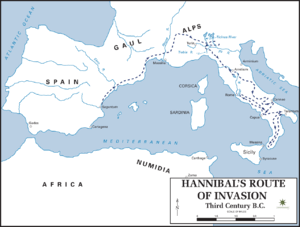Battle of Cannae
| Battle of Cannae | |||||||
|---|---|---|---|---|---|---|---|
| Part of the Second Punic War | |||||||
 Hannibal's route of invasion |
|||||||
|
|||||||
| Belligerents | |||||||
|
Allied African, Spanish, and Gallic tribes |
Allied Italian states: Etruscans Samnites Iapyges |
||||||
| Commanders and leaders | |||||||
|
Hannibal Maharbal Mago Gisgo Hanno Hasdrubal |
Gaius Terentius Varro Lucius Aemilius Paullus † |
||||||
| Strength | |||||||
|
50,000: 32,000 heavy infantry, 8,000 light infantry, 10,000 cavalry |
86,400: 40,000 Roman infantry, 40,000 allied infantry, 2,400 Roman cavalry, 4,000 allied cavalry |
||||||
| Casualties and losses | |||||||
|
Killed: 5,700 (Polybius) * 4,000 Gallic * 1,500 Spanish and African * 200 cavalry |
Killed: 53,500–75,000 Romans and allied infantry 2,700 Roman and allied cavalry Captured: 10,000 |
||||||
The Battle of Cannae (/ˈkæni/ or /ˈkæneɪ/) was a major battle of the Second Punic War that took place on 2 August 216 BC in Apulia, in southeast Italy. The army of Carthage, under Hannibal, surrounded and decisively defeated a larger army of the Roman Republic under the consuls Lucius Aemilius Paullus and Gaius Terentius Varro. It is regarded both as one of the greatest tactical feats in military history and as one of the worst defeats in Roman history.
Having recovered from their losses at Trebia (218 BC) and Lake Trasimene (217 BC), the Romans decided to engage Hannibal at Cannae, with roughly 86,000 Roman and allied troops. The Romans massed their heavy infantry in a deeper formation than usual, while Hannibal utilized the double-envelopment tactic. This was so successful that the Roman army was effectively destroyed as a fighting force. Following the defeat, Capua and several other Italian city-states defected from the Roman Republic to Carthage.
...
Wikipedia
